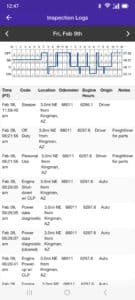A single hours of service (HOS) violation can lead to substantial fines, potentially exceeding $15,000, depending on severity and jurisdiction, which may impact a carrier’s bottom line. For trucking professionals and fleet managers, understanding and preventing these violations is essential for maintaining compliance and financial stability.
This comprehensive guide examines the current fine structures for HOS violations, prevention strategies, and how electronic logging devices (ELDs) can help support compliance efforts. Whether managing a fleet or operating independently, this information provides valuable insights for avoiding costly penalties and maintaining strong Compliance, Safety, Accountability (CSA) scores.
Do you have any questions? Talk to ELD Advisor: 650-405-3372 or Request Callback
Understanding DOT Hours of Service Fines
The Department of Transportation (DOT) enforces penalties for HOS violations, with fines structured to address various levels of non-compliance. Understanding these penalties is crucial for operational planning and risk management.
Current Fine Structures
The DOT fine structure for HOS violations includes:
- Egregious violations (exceeding driving limits by more than three hours). Fines may reach up to $16,000 according to current FMCSA guidelines.
- Standard HOS violations. These may range from approximately $1,000 to $15,000, depending on severity, circumstances, and jurisdiction.
- Systematic violations. For carriers with a documented pattern of non-compliance, penalties may reach $30,000 or higher based on current enforcement practices.
- Log falsification. Fines may reach approximately $15,846 for civil penalties. In cases where intentional falsification can be demonstrated, separate criminal proceedings may be possible under applicable federal regulations.
These fines represent direct costs to carriers and can significantly affect operational budgets.
Commonly Cited HOS Violations
DOT data indicates three primary categories of violations:
- Form and manner violations. Incomplete or improperly maintained logs can result in fines starting at $1,307 per instance.
- Log record accuracy issues. Inaccurate log entries may lead to penalties and could trigger increased scrutiny during subsequent inspections.
- Hours violations. Exceeding permitted driving hours or on-duty windows carries significant fines and impacts carrier safety ratings.
Recent Fine Adjustments
The DOT adjusts fines annually to account for inflation. Recent adjustments reflect increases of 3-5% across violation categories, with fines for standard violations rising from approximately $1,000 to $1,307. For the most current fine structures, carriers should consult the FMCSA website or qualified compliance professionals.
CSA Score Implications
CSA scores influence insurance rates and business opportunities. Based on current FMCSA methodology, HOS violations may affect scores as follows:
- Egregious violations (over three-hour driving limit). Up to 10 points.
- Systematic HOS violations. 7 points.
- Individual critical violations. 5 points.
- Form and manner violations. 1-3 points.
These points generally remain on record for 24 months, potentially impacting carrier evaluations and contract eligibility. CSA scores often serve as a metric for shippers assessing carrier reliability and compliance.
By staying informed about current HOS regulations and leveraging electronic logging technology, trucking professionals can develop strategies to mitigate risks, reduce the likelihood of violations, and maintain a strong compliance record.
Breakdown of HOS Rules and Common Violations
The Department of Transportation enforces several specific hours of service rules. Each rule may carry distinct penalties, and understanding these regulations helps carriers develop compliance strategies and protect their operations.
14-Hour Rule Violations
The 14-hour rule establishes that drivers must complete all driving within 14 consecutive hours of starting their duty period. Violations of this rule may result in penalties that, according to recent FMCSA enforcement data, typically start at approximately $2,500. Multiple infractions may increase the potential penalty up to approximately $7,500, depending on circumstances and jurisdiction. According to current CSA methodology, such violations may contribute approximately 7 points to a carrier’s CSA score, potentially affecting the carrier’s safety rating.
11-Hour Driving Limit Violations

DOT regulations limit driving time to 11 hours following 10 consecutive hours off duty. Based on recent enforcement actions, first-time violations may incur penalties around $3,000, though actual amounts can vary. Repeated violations that suggest a pattern of non-compliance may result in penalties that could reach up to approximately $15,876 in some cases. Under current scoring systems, the DOT may assign approximately 7 CSA points per incident, reflecting the serious nature of these violations.
30-Minute Break Requirements
Drivers must take a 30-minute break after 8 cumulative hours of driving. The DOT has established penalties for break requirement violations. According to recent enforcement trends, missing a required break may result in penalties of approximately $1,307. Taking an incomplete break period may carry similar penalties. Documentation errors related to break periods may incur penalties around $750, though enforcement practices vary. Based on current methodology, each violation may contribute approximately 5 points to a carrier’s CSA score.
60/70-Hour Limit Compliance
Carriers operate under either a 60-hour limit in 7 consecutive days or a 70-hour limit in 8 consecutive days, based on their operating schedule. Based on recent enforcement data, violations of these limits may incur penalties around $4,000, though actual amounts depend on specific circumstances. Multiple violations may potentially increase penalties up to approximately $12,000 in some cases. Under current scoring systems, the DOT may assign approximately 7 CSA points for each violation, highlighting the importance of total hours compliance.
Potential Cost Impact on Carriers
The financial consequences of HOS violations may extend beyond the initial penalties. These violations could potentially affect multiple aspects of carrier operations and may create various financial implications.
Direct Financial Impact
When a carrier receives an HOS violation, the immediate costs may include both the violation penalty and potential legal expenses. Carriers often find it beneficial to engage legal representation to address violations. Administrative costs may increase as staff members dedicate time to violation processing and preparation for potential audits. Many carriers also invest in additional compliance training, which may create both immediate and ongoing expenses.
Insurance Considerations
Insurance providers may respond to HOS violations with premium adjustments. According to industry reports, these increases have historically ranged from approximately 20% to 40% for carriers with significant violations, though individual cases vary considerably. These adjusted rates may remain in effect for several years following serious violations, typically 3 to 5 years according to common industry practice. Insurance carriers may also adjust deductibles or coverage options based on compliance history. The cumulative cost of these insurance impacts may in some cases exceed the original violation penalties.
Business Relationship Considerations
HOS violations may affect a carrier’s business relationships. Some shippers may reconsider relationships with carriers that demonstrate compliance issues. Access to certain shipping contracts could potentially become limited based on compliance history. Some brokers may consider compliance records when establishing business relationships. These factors may lead to adjusted security deposit requirements and potentially higher factoring rates for some carriers, which could affect operational costs.
Long-Term Operational Considerations
The extended impact of HOS violations may affect various business operations. Carriers with significant compliance issues may experience impacts to vehicle resale values. Financing costs might increase as lenders may view carriers with compliance challenges as representing different risk profiles. Overall business valuation could be affected, potentially limiting some expansion opportunities. Additionally, carriers with compliance concerns may face more frequent roadside inspections, which could create operational challenges.
Non-compliant carriers may also face increased regulatory oversight. The DOT may conduct more frequent audits and compliance reviews in some cases. These interventions may create additional administrative requirements. In severe cases involving systematic violations, significant operational changes may be required to restore normal operations.
Prevention Strategies
Preventing HOS violations requires a systematic approach to compliance. Successful carriers implement comprehensive strategies that protect their operations from costly DOT fines for hours of service violations while improving efficiency. Here are the key prevention strategies that every carrier should consider:
- Training best practices. A comprehensive training program forms the foundation of HOS compliance. This includes initial orientation for new drivers, regular refresher courses for experienced drivers, and ongoing updates about regulatory changes. Carriers should maintain detailed training records and regularly assess driver understanding to identify areas needing additional focus.
- Documentation procedures. Proper documentation provides the primary defense against violations. Carriers need clear procedures for maintaining accurate logs and supporting documents. These should include specific methods for recording duty status changes, managing supporting documents, and correcting log errors. Regular internal audits help identify potential compliance issues before they become violations.
- Pre-trip planning. Effective trip planning helps prevent HOS violations before drivers begin their routes. Dispatchers and drivers must collaborate to create realistic delivery schedules that account for required breaks, potential delays, and available hours. This includes consideration of traffic patterns, weather conditions, and construction zones that might affect driving time.
- Communication protocols. Clear communication between drivers, dispatchers, and compliance staff prevents many common DOT HOS violations. Carriers should establish specific protocols for reporting delays, requesting schedule adjustments, and addressing potential compliance issues. Regular updates about remaining available hours help dispatchers make informed decisions about load assignments.
Implementing these prevention strategies requires commitment from every level of the organization. While the initial investment in training, documentation systems, and communication tools may seem substantial, the cost is minimal compared to the potential fines and business disruption caused by HOS violations. Modern electronic logging devices support these prevention strategies by providing automated tools for tracking, documentation, and communication.

How ELDs Help Prevent HOS Violations
Electronic logging devices provide powerful tools for maintaining HOS compliance. These devices offer several key advantages over paper logs and help carriers prevent violations through automated tracking and real-time monitoring.
Real-Time Tracking Benefits
ELDs automatically record driving time and duty status changes, eliminating many common form and manner violations. The devices provide accurate, tamper-resistant records of driver activities, reducing the risk of log falsification allegations. Real-time tracking allows both drivers and managers to monitor hours compliance throughout the day, preventing unintentional violations.
The automated tracking system maintains precise records of driving time, on-duty periods, and required breaks. This accuracy helps carriers maintain compliance with complex HOS regulations while reducing the administrative burden on drivers and staff.
Automated Logging Advantages
Automated logging eliminates many common errors associated with paper logs. Electronic logbooks automatically record driving status based on vehicle movement, ensuring accurate documentation of drive time. The systems also simplify duty status changes, reducing the risk of form and manner violations caused by incomplete or incorrect log entries.
These devices maintain comprehensive records of all status changes, providing clear documentation for roadside inspections and DOT audits. The automated systems also help carriers maintain supporting documents by linking electronic records directly to driving events.
Alert Systems
Modern ELDs include sophisticated alert systems that warn drivers and managers about potential violations before they occur. These alerts notify drivers when they approach their daily driving limits or required break times. Early warnings allow drivers to plan stops and breaks effectively, preventing unintentional violations.
Fleet managers receive notifications about drivers approaching their hours limits, enabling proactive schedule adjustments. These alert systems also help identify patterns that might lead to violations, allowing carriers to address compliance issues before they result in penalties.
Compliance Monitoring Features
Electronic logging systems provide comprehensive compliance monitoring tools that help carriers identify and address potential violations quickly. These systems generate reports showing hours used, remaining time available, and any approaching limits. Fleet managers can review these reports to ensure all drivers maintain compliance with HOS regulations.
The monitoring features also help carriers track patterns in operations that might create compliance risks. This data allows companies to adjust schedules, routes, and procedures to prevent future violations effectively.

HOS247: A Reliable ELD Solution for Truckers
HOS247 delivers a top-rated electronic logging system designed for ease of use, compliance, and operational efficiency. Built to address the real-world challenges faced by truckers, the HOS247 electronic logbook provides a seamless experience with reliable hardware, a user-friendly interface, and industry-leading customer support.
- User-friendly interface. The HOS247 app is designed for quick navigation, allowing drivers to complete their logs with minimal effort. Clear displays and logical menus reduce the risk of errors and eliminate unnecessary paperwork. Even drivers with little experience using technology can adapt quickly.
- Reliable hardware. Built to withstand the demands of daily trucking, the HOS247 ELD device connects securely to the vehicle’s diagnostic port, ensuring stable data transmission. The system prevents logging interruptions, avoiding compliance risks caused by connection failures or data gaps.
- Multilingual customer support. HOS247 provides top-rated assistance in English, Spanish, Russian, and Polish. Available seven days a week, the support team is knowledgeable about trucking regulations and ready to resolve issues quickly. The callback policy ensures drivers are never left waiting for help.
- No-contract policy. HOS247 allows carriers to use the system on a flexible subscription basis with no long-term commitments. Fleets can scale their elog implementation as needed, without worrying about hidden fees or cancellation penalties.
- Automatic compliance updates. The HOS247 system stays up to date with the latest FMCSA regulations to help carriers avoid DOT hours of service violations fines. Software updates are applied automatically, ensuring continued compliance without requiring manual intervention from drivers or fleet managers.
- Seamless integration. HOS247 ELDs connect with fleet management systems, dispatch software, and vehicle maintenance tracking tools. This integration centralizes fleet data, streamlining operations and reducing administrative workload.
HOS247 is committed to providing truckers with a hassle-free ELD solution that enhances efficiency while ensuring compliance. With a driver-first design, durable hardware, and dedicated customer support, HOS247 helps carriers and independent drivers simplify their logging process and focus on the road ahead.
Best Practices for Using ELDs
Professional drivers and fleet managers can maximize the benefits of their electronic logging devices by following established best practices. A systematic approach to elog usage helps ensure consistent compliance while minimizing technical difficulties.

Performing Daily Device Checks
The foundation of reliable operation begins with daily device checks. Drivers should start each shift by verifying their ELD’s proper operation. This includes checking the connection between the device and the vehicle’s diagnostic port, confirming the display screen functions correctly, and ensuring the system accurately shows their current duty status. These morning checks help identify potential issues before they affect compliance during the driving day.
Implementing Data Backup Procedures
Data backup procedures protect carriers against unexpected technical issues and ensure information availability for audits. While electronic logbooks automatically record driving data, carriers should implement regular backup protocols. Fleet managers should download and secure ELD records at least weekly, with many operations choosing daily backups for additional security. These backups provide protection against device malfunctions and ensure complete records are available when needed for compliance verification.
Establishing Driver Training Essentials
Driver training essentials extend beyond basic device operation. Comprehensive training should cover log editing procedures, management of unassigned driving time, and proper use of special driving categories such as yard moves and personal conveyance. Drivers need to understand how to document and annotate changes to their logs, ensuring all modifications meet compliance requirements. This training should include hands-on practice with actual devices, allowing drivers to build confidence in their ability to maintain accurate records.
Managing Common Troubleshooting Issues
Common troubleshooting knowledge helps drivers address routine technical issues without delay. Drivers should learn to recognize standard error messages, understand basic diagnostic procedures, and know when to seek technical support. This knowledge prevents minor technical problems from escalating into compliance violations. Fleet managers should provide drivers with quick reference guides covering frequent issues and their solutions.
Following Regular Maintenance Schedules
Maintenance schedules ensure ELDs continue to operate reliably over time. Monthly system checks should include verifying software versions, confirming accurate vehicle parameter settings, and testing all required functions. Regular maintenance helps identify potential issues before they affect compliance and extends the useful life of the equipment. Fleet managers should document all maintenance activities and keep detailed records of system updates and repairs.
The success of an electronic logging program depends on consistent application of these best practices across the entire operation. By implementing these procedures systematically, carriers can maintain reliable electronic logging while minimizing the risk of compliance violations.

Conclusion
Hours of service compliance directly impacts every aspect of trucking operations, from daily scheduling to long-term business success. Throughout this guide, we have examined the serious consequences of violations, including substantial DOT HOS fines, increased insurance costs, and damaged CSA scores. Understanding these impacts helps carriers appreciate the importance of maintaining consistent compliance.
The transition to electronic logging devices represents more than just a regulatory requirement – it provides an opportunity to improve operational efficiency while ensuring compliance. Modern electronic logbooks offer powerful tools for maintaining accurate records, preventing violations, and managing driver hours effectively. These benefits extend beyond basic compliance, contributing to improved safety and operational control.
Now is the time to evaluate your current compliance measures and consider whether your electronic logbook meets your operational needs. Consider factors such as ease of use, reliability, available support, and the provider’s commitment to ongoing system improvements. The right ELD system, combined with proper training and consistent procedures, forms the foundation of successful hours of service compliance.
Disclaimer: This article provides general information about hours of service regulations and potential penalties. It is not intended as legal advice. Regulations, enforcement practices, and fine structures may vary by jurisdiction and are subject to change. Fleet operators and drivers should consult with qualified legal professionals and regularly review FMCSA updates for the most current compliance requirements applicable to their specific situation.

As an expert in B2B and B2C sales, I’ve dedicated myself to perfecting sales processes and client retention strategies in the logistics and trucking industry. I have significantly contributed to the expansion of the ELD service, catering to retail and wholesale clients in need of HOS247 ELD solutions. My unwavering commitment to implementing state-of-the-art sales techniques and technologies ensures the continuous growth and success of businesses I work with.












Department of Transportation (DOT) hours of service (HOS) regulations are aimed at promoting safety and operational efficiency in the trucking industry. But what do these rules represent, and how do they impact fleet operations? As a driver, failure to comply

GPS asset tracking revolves around the use of the Global Positioning System (GPS) to monitor and manage the location and movements of physical assets, such as vehicles, equipment, or cargo, from a distance. This means whether your fleet is moving

A driver is on a critical, time-sensitive delivery. At a roadside inspection, the elog freezes. The officer is waiting, dispatch is on hold, and the driver’s entire Hours of Service (HOS) log is suddenly in question. This scenario is a